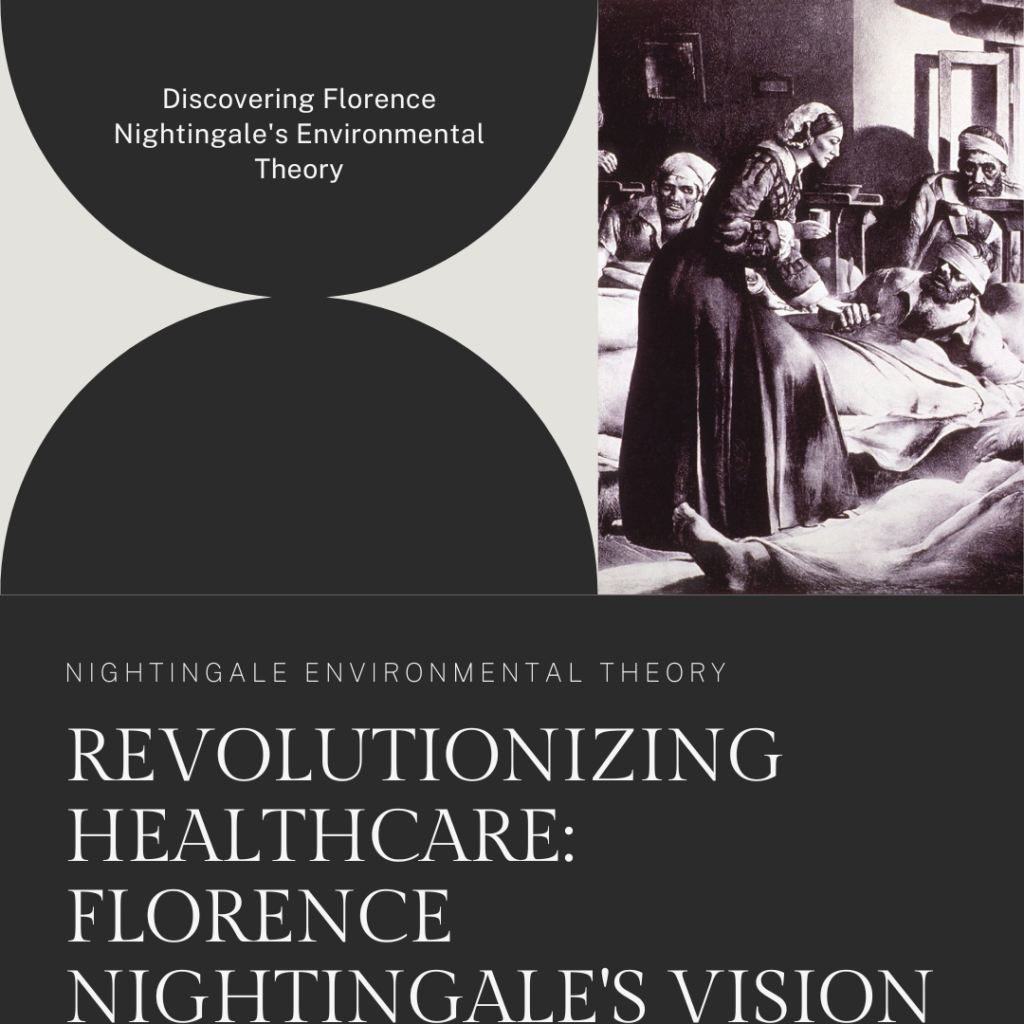Florence Nightingale’s Environmental Theory
Introduction to Florence Nightingale’s Environmental Theory
Overview and Significance
Florence Nightingale’s Environmental Theory is a foundational concept in nursing that emphasizes the critical role of the environment in patient care and recovery. Nightingale proposed that a clean, well-ventilated, and quiet environment could significantly improve health outcomes and prevent disease. This theory underscores the importance of environmental factors in maintaining and restoring health.

Historical Context
Florence Nightingale developed her Environmental Theory during the mid-19th century, a time when sanitary conditions in hospitals were poor, and infection rates were high. Her experiences during the Crimean War highlighted the impact of the environment on patient health, leading her to advocate for better hygiene practices and hospital design.
Key Principles of Nightingale’s Environmental Theory
Cleanliness
Cleanliness is a cornerstone of Nightingale’s Environmental Theory. She believed that maintaining a clean environment reduces the risk of infection and promotes healing. This principle includes regular cleaning of patient areas, sterilization of medical equipment, and personal hygiene practices for both patients and healthcare providers.
Ventilation and Warmth
Proper ventilation and warmth are essential components of a healthy environment. Nightingale emphasized the importance of fresh air to remove harmful pathogens and improve respiratory health. Additionally, maintaining a comfortable temperature is crucial for patient comfort and recovery.
Light
Nightingale recognized the therapeutic effects of natural light on patients. She advocated for maximizing exposure to daylight while also managing artificial lighting to support the body’s natural rhythms and enhance the overall well-being of patients.
Noise
Minimizing noise is another key principle of Nightingale’s theory. Excessive noise can cause stress and hinder recovery. Nightingale recommended creating a quiet environment to promote rest and reduce anxiety, which is particularly important in hospital settings.
Nutrition
Adequate nutrition is vital for patient recovery. Nightingale stressed the importance of providing nutritious and palatable meals to support the body’s healing processes. She believed that good nutrition could strengthen the immune system and enhance patient outcomes.
Impact of Nightingale’s Theory on Modern Nursing
Infection Control
Nightingale’s Environmental Theory has had a profound impact on infection control practices. Her emphasis on cleanliness and hygiene laid the groundwork for modern infection prevention protocols. Hospitals today implement stringent cleaning procedures and use advanced sterilization techniques to minimize the risk of infections.
Hospital Design and Hygiene
Nightingale’s ideas have influenced the design and layout of hospitals. Modern hospitals are designed to maximize natural light, ensure proper ventilation, and reduce noise levels. These design elements create a more healing environment for patients and support better health outcomes.
Patient Recovery and Outcomes
By focusing on environmental factors, Nightingale’s theory has contributed to improved patient recovery rates and overall health outcomes. Clean, well-ventilated, and quiet environments help reduce stress, prevent infections, and promote faster recovery.
Practical Applications of Nightingale’s Environmental Theory
Creating a Healing Environment
Applying Nightingale’s principles involves creating a healing environment that supports patient recovery. This includes designing patient rooms with ample natural light, ensuring good air circulation, and maintaining a comfortable temperature.
Implementing Cleanliness Protocols
Hospitals and healthcare facilities implement rigorous cleanliness protocols to align with Nightingale’s theory. These protocols include regular cleaning schedules, disinfection of high-touch surfaces, and proper disposal of waste to prevent contamination.
Ensuring Proper Ventilation
Proper ventilation is achieved through well-designed HVAC systems that provide a constant supply of fresh air while removing stale air and contaminants. This is particularly important in areas like operating rooms and intensive care units.
Managing Light and Noise
Healthcare providers manage light and noise levels to create a conducive environment for healing. This may involve using blackout curtains to control natural light, installing soundproof materials, and establishing quiet hours to reduce noise disturbances.
Providing Adequate Nutrition
Dietitians and nutritionists work closely with healthcare teams to ensure that patients receive balanced, nutritious meals. Special dietary plans are developed based on individual patient needs to support their recovery and overall health.
Conclusion
Summary of Key Points
Florence Nightingale’s Environmental Theory emphasizes the importance of a clean, well-ventilated, and quiet environment in promoting patient health and recovery. Her principles of cleanliness, ventilation, light, noise reduction, and nutrition have profoundly influenced modern nursing practice and hospital design.
Continuing Relevance
Nightingale’s Environmental Theory remains relevant today, guiding best practices in infection control, hospital design, and patient care. By creating a healing environment that adheres to her principles, healthcare providers can enhance patient outcomes and support overall well-being.
